-
 Bitcoin
Bitcoin $106,437.2012
0.82% -
 Ethereum
Ethereum $2,442.5287
0.82% -
 Tether USDt
Tether USDt $1.0005
-0.02% -
 XRP
XRP $2.1812
-0.27% -
 BNB
BNB $645.1327
0.45% -
 Solana
Solana $146.2379
0.39% -
 USDC
USDC $0.9999
-0.01% -
 TRON
TRON $0.2751
0.92% -
 Dogecoin
Dogecoin $0.1662
-0.23% -
 Cardano
Cardano $0.5827
-1.22% -
 Hyperliquid
Hyperliquid $37.5225
0.04% -
 Bitcoin Cash
Bitcoin Cash $479.0877
4.02% -
 Sui
Sui $2.7846
-3.27% -
 Chainlink
Chainlink $13.3576
0.84% -
 UNUS SED LEO
UNUS SED LEO $9.0252
-1.20% -
 Stellar
Stellar $0.2455
-1.07% -
 Avalanche
Avalanche $18.0680
-1.81% -
 Toncoin
Toncoin $2.8948
-1.07% -
 Shiba Inu
Shiba Inu $0.0...01164
-1.65% -
 Litecoin
Litecoin $85.0637
-0.06% -
 Hedera
Hedera $0.1526
-0.89% -
 Monero
Monero $316.2941
0.78% -
 Ethena USDe
Ethena USDe $1.0003
-0.04% -
 Polkadot
Polkadot $3.4113
-1.87% -
 Dai
Dai $1.0000
-0.01% -
 Bitget Token
Bitget Token $4.4488
5.16% -
 Uniswap
Uniswap $7.1740
3.09% -
 Pi
Pi $0.5968
11.43% -
 Pepe
Pepe $0.0...01010
-0.65% -
 Aave
Aave $264.3189
0.40%
How to interpret the stochastic indicator repeatedly oscillating near the 50-level line?
The stochastic indicator hovering around 50 suggests market indecision, often signaling consolidation or a pending breakout in crypto trading.
Jun 25, 2025 at 10:28 am
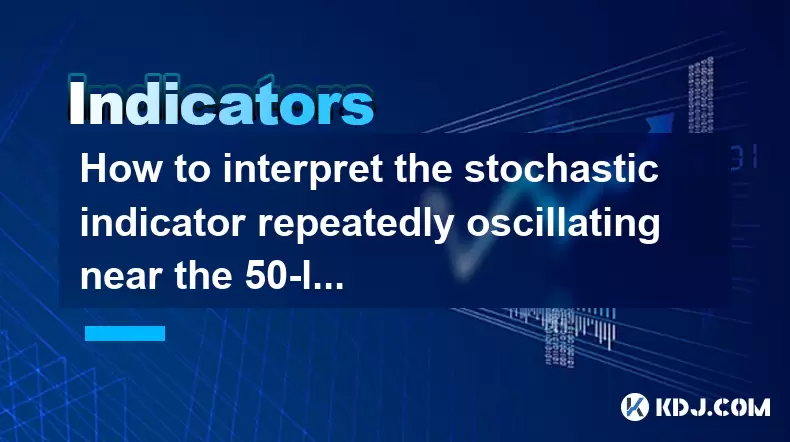
Understanding the Stochastic Indicator
The stochastic indicator is a momentum oscillator commonly used in technical analysis to assess overbought and oversold conditions in financial markets, including cryptocurrency trading. It compares a particular closing price of an asset to a range of its prices over a certain period, typically 14 periods. The indicator consists of two lines: %K (fast stochastic) and %D (slow stochastic), which move between 0 and 100.
When traders observe the stochastic indicator oscillating near the 50-level line, it often signals indecision in the market. This level acts as a midpoint between overbought (above 80) and oversold (below 20) territories. In the context of cryptocurrencies, where volatility is high and trends can reverse quickly, understanding this oscillation becomes crucial for accurate trade positioning.
What Does Repeated Oscillation Around 50 Mean?
When both the %K and %D lines repeatedly hover around the 50-level without crossing into extreme zones, it reflects a lack of strong directional bias. This behavior indicates that neither bulls nor bears are gaining control. In crypto markets, such patterns are common during consolidation phases or when major news events are pending.
A repeated bounce near 50 suggests that each attempt by buyers or sellers to push the price higher or lower is met with counter-pressure. For instance, if Bitcoin’s stochastic lines keep returning to 50 after brief spikes up or down, it may indicate that the market is waiting for a catalyst before committing to a new trend.
Identifying Market Conditions Through Stochastic Behavior
In the realm of cryptocurrency trading, identifying whether the market is trending or ranging is essential. When the stochastic indicator remains confined around the 50-level for extended periods, it often points to a sideways or non-trending market. This pattern can be especially useful when combined with other tools like Bollinger Bands or volume indicators.
Traders should pay attention to how the price behaves alongside the stochastic movement. If the price is moving within a tight range while the stochastic lingers around 50, it confirms the lack of momentum. However, if the price begins to form higher highs or lower lows despite the stochastic hovering at 50, it could signal an impending breakout.
How to Use This Signal in Crypto Trading Strategies
For those actively involved in cryptocurrency trading, interpreting the stochastic oscillator's repeated interaction with the 50-level can inform entry and exit decisions. Here’s how you can incorporate this observation into your strategy:
- Watch for Breakouts: If the stochastic lines break above or below the 50-level decisively and remain there, it could signal the start of a new trend.
- Combine with Price Action: Look for candlestick patterns or support/resistance levels aligning with the stochastic behavior for confluence.
- Avoid Overtrading: During prolonged 50-level oscillations, avoid making aggressive trades unless confirmed by volume or other momentum indicators.
For example, if Ethereum’s stochastic lines have been bouncing around 50 for several hours, but then the price breaks out of a triangle pattern with increasing volume, it might be a good time to consider entering a position in the direction of the breakout.
Common Pitfalls and How to Avoid Them
Many novice traders misinterpret the stochastic indicator’s behavior around the 50-level as a sign of weakness or strength. However, it’s important not to treat this as a standalone reversal signal. Instead, use it as a tool to gauge current market sentiment rather than predicting future movements.
One common mistake is trying to “fade” the 50-level — meaning selling every time it approaches from above or buying every time it dips below. In fast-moving crypto markets, this approach can lead to losses if a sudden surge in momentum catches the trader off guard.
Instead, traders should focus on confirming signals using additional tools such as moving averages, Fibonacci retracements, or chart patterns. Also, setting stop-loss orders and maintaining proper risk management is vital when trading based on stochastic readings.
Frequently Asked Questions (FAQs)
Q: Is the 50-level on the stochastic a reliable support/resistance marker?
While the 50-level can act as a psychological midpoint, it should not be treated as a fixed support or resistance level. Its significance depends on broader market dynamics and should be validated with other technical tools.
Q: Can I base my trades solely on the stochastic oscillator near 50?
It’s generally not advisable to rely solely on any single indicator. Combining the stochastic with volume, trendlines, or other oscillators improves reliability, especially in volatile crypto markets.
Q: What timeframes work best for analyzing stochastic behavior near 50?
Shorter timeframes like 1-hour or 4-hour charts provide more frequent signals, but they can also generate false signals. Daily charts offer clearer context, particularly for swing traders monitoring longer-term consolidation phases.
Q: Should I ignore the stochastic if it stays near 50 for too long?
Not necessarily. A prolonged stay near 50 can indicate market indecision, which might precede a significant move. Traders should monitor for a breakout in either direction and prepare accordingly.
Disclaimer:info@kdj.com
The information provided is not trading advice. kdj.com does not assume any responsibility for any investments made based on the information provided in this article. Cryptocurrencies are highly volatile and it is highly recommended that you invest with caution after thorough research!
If you believe that the content used on this website infringes your copyright, please contact us immediately (info@kdj.com) and we will delete it promptly.
- DEX Race Heats Up: Paradigm's Bet on GTE and the Startup Investment Landscape
- 2025-06-25 14:55:12
- Pepe Coin's Wild Ride: Liquidation Zones, Trump's Crypto Crash, and the Allure of APY
- 2025-06-25 14:55:12
- Passive Income, Cryptos, and ROI: Troller Cat Leads the Meme Coin Revolution in 2025
- 2025-06-25 15:00:12
- Cryptos, Buy Now, Beta Version: Riding the Meme Coin Wave with Troller Cat and Beyond
- 2025-06-25 15:00:12
- Athena Bitcoin & Crypto ATMs: Scam Crackdown & Resale Shares?
- 2025-06-25 15:05:12
- Microsoft, Xbox, Layoffs: Navigating the Shifting Landscape
- 2025-06-25 15:05:12
Related knowledge
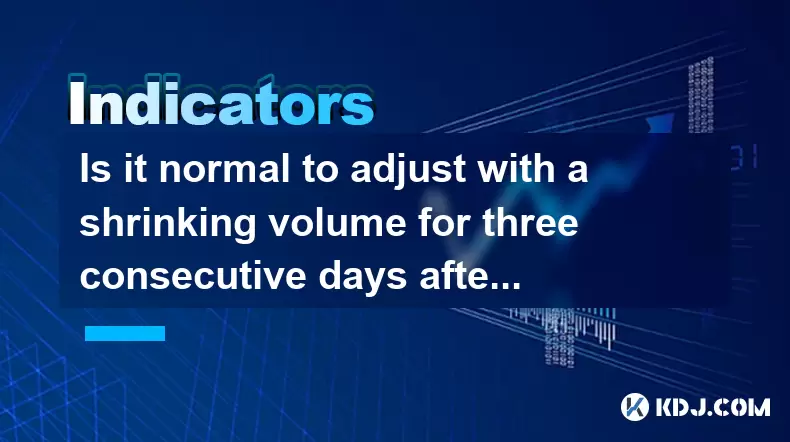
Is it normal to adjust with a shrinking volume for three consecutive days after breaking through the previous high with a large volume?
Jun 25,2025 at 03:49pm
Understanding Volume and Price Relationship in Cryptocurrency TradingIn cryptocurrency markets, volume is a critical metric that reflects the number of assets traded over a specific period. When a cryptocurrency breaks through a previous high with large volume, it typically signals strong buying pressure and market confidence. However, it's not uncommon...
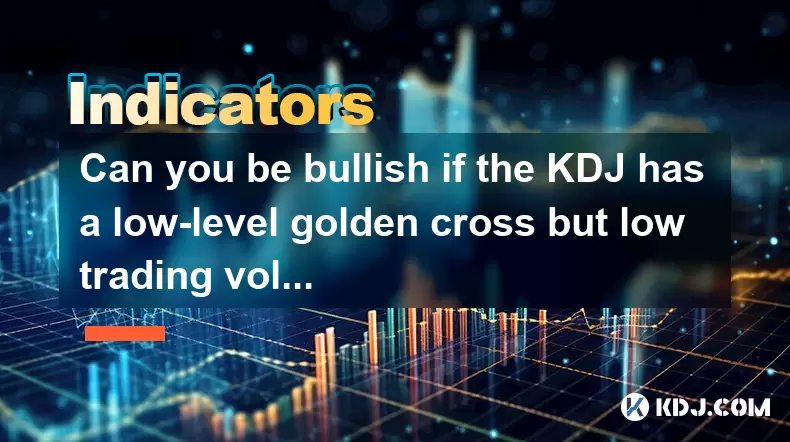
Can you be bullish if the KDJ has a low-level golden cross but low trading volume?
Jun 25,2025 at 03:14pm
Understanding the KDJ Indicator in Cryptocurrency TradingThe KDJ indicator, also known as the stochastic oscillator, is a momentum-based technical analysis tool widely used in cryptocurrency trading. It comprises three lines: the %K line (fast stochastic), the %D line (slow stochastic), and the J line (divergence value). These lines oscillate between 0 ...
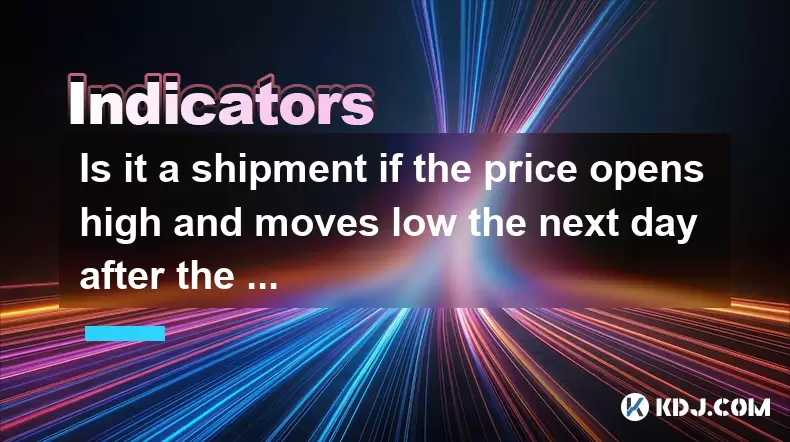
Is it a shipment if the price opens high and moves low the next day after the daily limit with huge volume?
Jun 25,2025 at 12:56pm
Understanding the Concept of a Shipment in Cryptocurrency TradingIn cryptocurrency trading, the term shipment refers to a scenario where large volumes of an asset are sold off rapidly, often leading to a significant price drop. This is typically associated with whale activity or coordinated selling by major holders. When traders observe certain patterns...
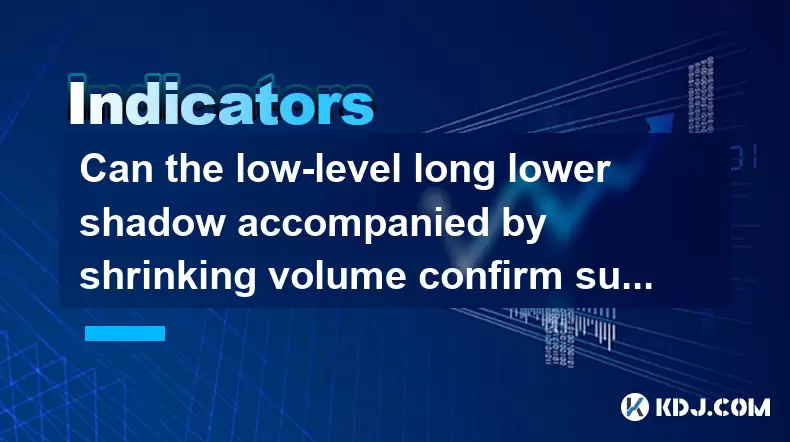
Can the low-level long lower shadow accompanied by shrinking volume confirm support?
Jun 25,2025 at 03:08pm
Understanding the Long Lower Shadow Candlestick PatternA long lower shadow candlestick pattern occurs when a candle closes near its high but has a significantly long lower wick, indicating that sellers pushed prices down during the session but were met with strong buying pressure that drove the price back up. This pattern is often seen as a potential si...
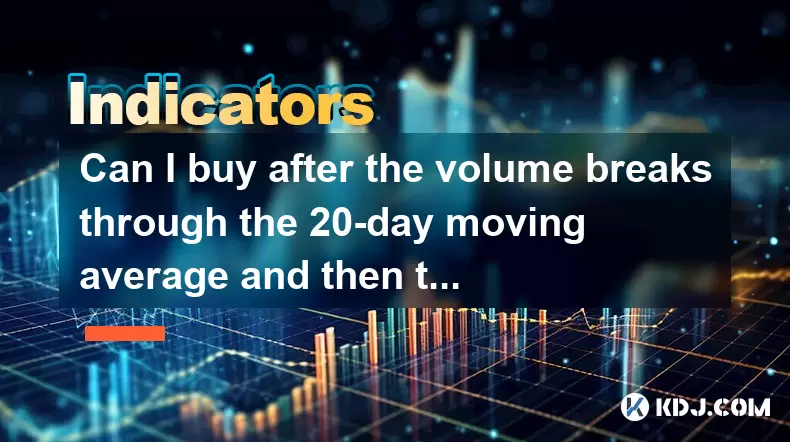
Can I buy after the volume breaks through the 20-day moving average and then the volume shrinks and then the callback is pulled back?
Jun 25,2025 at 12:00pm
Understanding Volume and Moving Averages in Cryptocurrency TradingIn the world of cryptocurrency trading, volume and moving averages are two critical indicators that traders rely on to make informed decisions. The 20-day moving average (MA) is a popular tool used to identify trends and potential entry or exit points. When volume breaks through this aver...
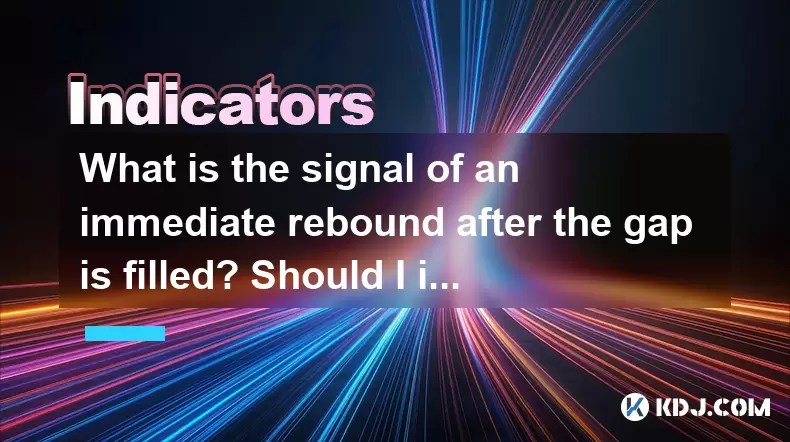
What is the signal of an immediate rebound after the gap is filled? Should I intervene?
Jun 25,2025 at 01:15pm
Understanding Gaps in Cryptocurrency TradingIn cryptocurrency trading, a gap occurs when the price of an asset jumps from one level to another without any trading happening in between. This typically happens during periods of high volatility or after significant news events that impact market sentiment overnight or over weekends. The phenomenon is commo...

Is it normal to adjust with a shrinking volume for three consecutive days after breaking through the previous high with a large volume?
Jun 25,2025 at 03:49pm
Understanding Volume and Price Relationship in Cryptocurrency TradingIn cryptocurrency markets, volume is a critical metric that reflects the number of assets traded over a specific period. When a cryptocurrency breaks through a previous high with large volume, it typically signals strong buying pressure and market confidence. However, it's not uncommon...

Can you be bullish if the KDJ has a low-level golden cross but low trading volume?
Jun 25,2025 at 03:14pm
Understanding the KDJ Indicator in Cryptocurrency TradingThe KDJ indicator, also known as the stochastic oscillator, is a momentum-based technical analysis tool widely used in cryptocurrency trading. It comprises three lines: the %K line (fast stochastic), the %D line (slow stochastic), and the J line (divergence value). These lines oscillate between 0 ...

Is it a shipment if the price opens high and moves low the next day after the daily limit with huge volume?
Jun 25,2025 at 12:56pm
Understanding the Concept of a Shipment in Cryptocurrency TradingIn cryptocurrency trading, the term shipment refers to a scenario where large volumes of an asset are sold off rapidly, often leading to a significant price drop. This is typically associated with whale activity or coordinated selling by major holders. When traders observe certain patterns...

Can the low-level long lower shadow accompanied by shrinking volume confirm support?
Jun 25,2025 at 03:08pm
Understanding the Long Lower Shadow Candlestick PatternA long lower shadow candlestick pattern occurs when a candle closes near its high but has a significantly long lower wick, indicating that sellers pushed prices down during the session but were met with strong buying pressure that drove the price back up. This pattern is often seen as a potential si...

Can I buy after the volume breaks through the 20-day moving average and then the volume shrinks and then the callback is pulled back?
Jun 25,2025 at 12:00pm
Understanding Volume and Moving Averages in Cryptocurrency TradingIn the world of cryptocurrency trading, volume and moving averages are two critical indicators that traders rely on to make informed decisions. The 20-day moving average (MA) is a popular tool used to identify trends and potential entry or exit points. When volume breaks through this aver...

What is the signal of an immediate rebound after the gap is filled? Should I intervene?
Jun 25,2025 at 01:15pm
Understanding Gaps in Cryptocurrency TradingIn cryptocurrency trading, a gap occurs when the price of an asset jumps from one level to another without any trading happening in between. This typically happens during periods of high volatility or after significant news events that impact market sentiment overnight or over weekends. The phenomenon is commo...
See all articles























































































